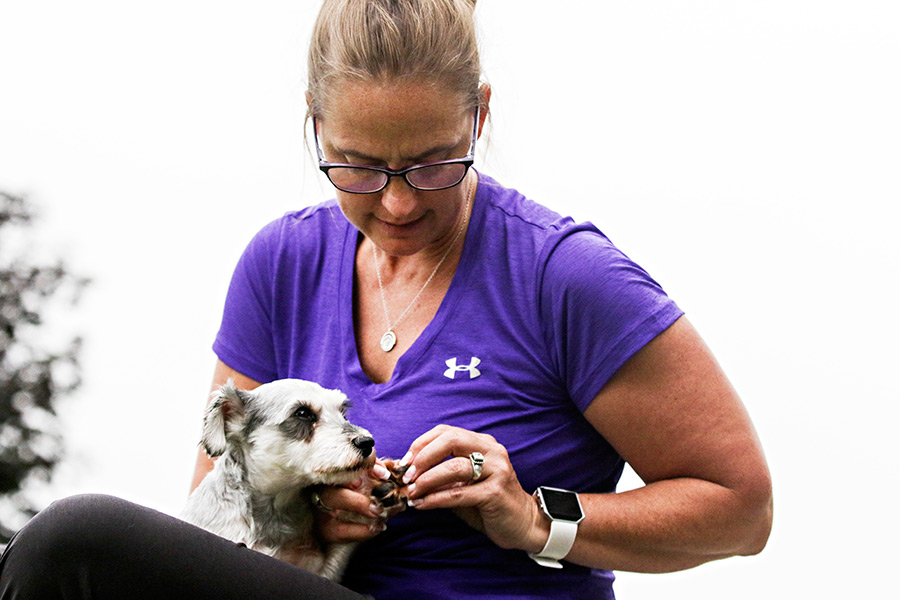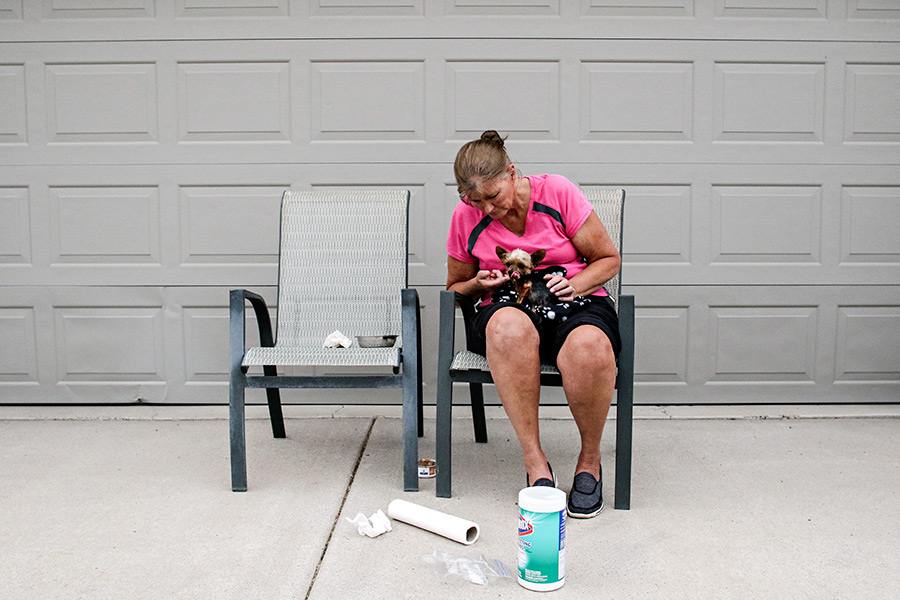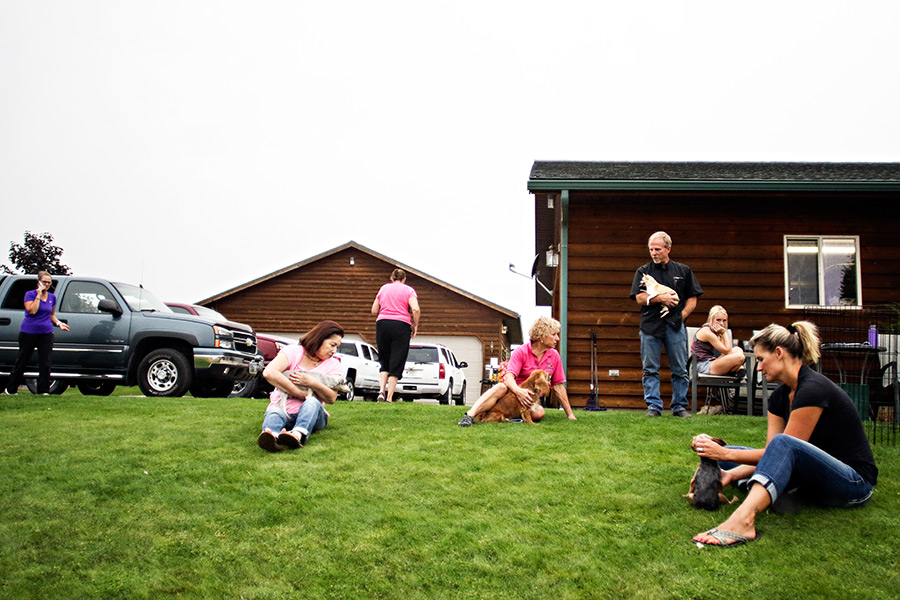The 9-year-old toy spaniel with her ears splayed like butterfly-wings is called Sara. She’s unable to stand because her legs are atrophied and her bones are brittle from overbreeding, and she can’t lie down because her pregnant tummy is too swollen with her next litter.
Her only option is to balance awkwardly on a patch of grass, perched there as though she performed some ungainly belly flop onto a beach ball, draping it in a furry fringe of snow-white and waiting to give birth. Again.
She’s called Sara, but until a week ago she had no name. The breeders who owned her referred only to a microchip number, 097-541-070. Sara wasn’t a pet; she was inventory.
Sara is among 130 dogs rescued last month from a so-called “puppy mill” near Charlo, where a husband-and-wife commercial breeding operation, LDR Kennel, had been churning out dogs since 2002, selling hundreds of puppies while warehousing the breeding parents in cramped, deplorable conditions—they lived in stacked wire cages, defecating and urinating through a grate, spinning in tight radial circles until it was time to mate.
Prior to her rescue, Sara had never socialized with humans or walked on grass. Her entire world was confined to the wire cage and, having only eaten and drank from pellet dispensers and rabbit feeders set to timers, she doesn’t know how to bowl feed.
Her two remaining teeth are rotted black and her paws are raw-red, and if she survives this pregnancy, it will be her last litter before she’s spayed.
But for Sara and the other dogs, a long and costly road lies ahead before adoption.
“Dogs don’t receive human contact at a puppy mill, so for her to be around humans right now is a totally new experience,” said Lynette Duford, of Life Savers Animal Rescue in Polson, the small nonprofit organization that is arranging medical care and foster homes for the seized animals while acclimating them to compassionate volunteers.
“If you saw her a few days ago, you wouldn’t recognize her,” Duford said. “She was so traumatized. She’s come a long way. But she has a long way to go.”
Duford and her husband, Dana, have dubbed their Polson home Camp Duford because of the dozens of displaced dogs that now reside there, awaiting medical care and, eventually, adoption. They’re mostly small breeds—Chihuahuas, Maltese, Yorkshire Terriers, Havanese, Shih Tzus—which are much easier to breed on a large scale in limited space than larger breeds.
And then there’s Sara, the toy spaniel, or Papillon, which is French for “butterfly.”

The manicured lawn flanking Camp Duford has been converted into a veritable triage unit, and every evening since the rescue, a dozen or so volunteers have converged there to care for the dogs, swaddling them in blankets, rehydrating them with syringes, soaking them in medicated baths, and providing a calm presence. On the outskirts of the lawn, two volunteers sit with Sara, holding constant vigil.
Each dog will require multiple surgical operations before they are adoptable. Their teeth will be pulled, their sockets cleaned, their gums sutured. They’ll be spayed and neutered, each surgery costing hundreds of dollars in veterinary care.
And because Montana has no law providing cost of animal care in cruelty cases, Life Savers is shouldering the financial burden.
“Our organization is basically six women, and last year we lost $15,000,” said Duford, who holds a full-time job at the Lake County Health Department. “But I’m not complaining. I’m more than happy to take this on. I’ve been on Cloud 9 ever since the rescue.”

The puppy mill in Charlo is just one example in a spate of recent cases in western Montana in which domestic animals were found living in appalling conditions, usually dehydrated, underweight and suffering from serious health issues.
A few weeks earlier, more than 120 animals were rescued from a puppy mill in Libby, including 49 poodles, one Borzoi, two Plott hound dogs, one yellow Labrador puppy, six donkeys, and some 60 birds. Their fur was matted and their rib cages pronounced, and the breeder has been charged with multiple counts of aggravated animal cruelty, a felony.
The animals are now housed at the Lincoln County Animal Shelter, a public facility that is over capacity, understaffed and over budget.
Unlike a majority of states in the country, Montana has no law that provides for the cost of caring for animals after they are seized in a cruelty case, so that cost typically falls on the taxpayers or the goodwill of the community. The Humane Society of the United States and a clutch of advocates have been urging Montana’s Legislature to pass a law to put that financial burden on the suspected abusers, and to regulate commercial breeders.
Montana’s laws don’t limit the number of dogs a breeder can raise, nor do they clearly define who is a breeder, nor do they require licensing or inspections.
Not only do puppy mills pass on bad genetics and a host of costly health problems to their customers, advocates of the reform say, the most egregious businesses are eventually raided and closed, leaving the public, local animal shelters and communities to care for the animals, a significant burden to Montana’s limited infrastructure and the state’s pocketbook.
But legislative session after divided session, the bills have failed.
“It is just so incredibly frustrating,” said Cliff Bennett, director of the Flathead County Animal Shelter, which has housed scores of seized animals on multiple occasions in the past. “It’s a repeating scenario, and it’s happening for no other reason than the Montana Legislature refuses to pass this bill.”
Bennett has heard all of the arguments opposing new puppy mill legislation. He understands the concerns about privacy and government intrusion, and he’s talked to ranchers who think a puppy mill bill will set a cumbersome precedent, foisting new regulations on their livestock operations and inviting government agencies onto their property.
“That is just preposterous, but that is the kind of ignorance surrounding this issue,” Bennett said. “I’m a fifth-generation farm boy. I’m a Republican and a fiscal conservative. I get it. But we have had multiple cases right here in a 30-day period that have essentially shut down our county services. How are we supposed to serve the public when we’re caring for hundreds of animals seized from some nutcases?”
“It’s my fault that I haven’t done enough, but next session I am going to camp out in Helena and make some noise.”
Patti Prato, a retired veterinarian in Missoula caring for 45 of the dogs rescued in Charlo, has been making noise for more than a decade, rattling the cage of the Legislature and rallying support for a “puppy-mill bill” ever since she first learned of the suspected abuse at LDR Kennel.
“We’ve been trying to shut this particular breeder down for over a decade,” Prato said. “They were the impetus for us trying to get the bill passed. LDR was the main focus that got the ball rolling, but this decade of effort should never have taken a decade.”

In 2007, Democrat Dave McAlpin, who at the time represented Missoula’s House District 94, sponsored a so-called “puppy mill bill” at Prato’s behest, and while it failed, they were eager to keep the issue alive, reasoning that lawmakers would come around the following session.
Since then, numerous neglect and animal cruelty cases have come to light statewide, demonstrating a clear need for increased regulation, McAlpin said. But the bills keep failing, and McAlpin says Montana’s lack of regulations have made the state a draw for unscrupulous commercial breeders.
“There is evidence that some of the bad actors in puppy mills in Montana have come from other states,” he said. “Without any laws, we have become a magnet for these kinds of puppy mills.”
Other puppy mill bills have failed in 2009, 2011, 2013, and 2015.
In 2013, House District 54 Rep. Margie MacDonald, D-Billings, introduced HB 439, the “Montana Commercial Pet Protection Act” to the Agricultural Committee.
The bill would have ensured that commercial pets bred, sold or made available for adoption in Montana are healthy. The bill included inspections of dog breeding facilities and outlined standards of care for feeding and watering while collecting fees from breeders to offset the cost of inspections.
“The committee was extremely leery of those regulations,” MacDonald said.
The bill failed. MacDonald reintroduced it again in 2015 as HB 608, this time in the Department of Labor and Industry oversight committee. Again, it failed.
Krayton Kerns, a former conservative legislator and veterinarian in Laurel, was chairman of the House Agriculture Committee at the time, and has challenged puppy mill bills at every turn.
Kerns argues that as long as a demand exists for cheap dogs, puppy mills will continue to propagate animals, and while he admits that irresponsible breeders are a reality in Montana, he doesn’t think it’s reason enough to impose additional layers of governmental restrictions that would also apply to the state’s responsible breeders.
“Every one of these bills forces me to regulate people who are amazing, responsible breeders, and I just will not subject these great people to that level of government regulation,” Kerns said. “As long as people are out there looking for cheap puppies, there will be puppy mills. The market drives it. But there is not a legislative solution.”
Stacey Gordon, who teaches Animal Law at the University of Montana and is president of the Humane Society of Western Montana Legislative Committee, has been working to help push a bill through the Legislature for years, but continually encounters the “slippery-slope” argument.
“Opponents to this bill say that it is going to snowball and allow the state to go into your bedroom and inspect it,” Gordon said. “Well, if you are raising 100 puppies in your bedroom, maybe so. But most people don’t do that.”
Last session, Gordon spoke with Lake County legislators about the situation at LDR Kennel, explaining “if you have puppy mills in your backyard, they will bankrupt your county,” and that new regulations are the only solution.
“There is no way to get a handle on commercial breeders without regulation,” she said. “We need licensing and inspection. All other businesses are licensed and have some form of regulation. It costs money because you have to hire someone to inspect, but I don’t know how to do it for free.”

“As heartbreaking as a puppy mill is when you see the photos of these poor animals, the leading issue is an economic one,” McAlpin said. “It costs us 10 times to remedy a situation on the back end versus what it would cost through inspections to get rid of the bad apples on the front end.”
For Prato, her mission has been as much personal as it is systemic.
In 2005, a client arrived at Prato’s vet clinic in Missoula with an underweight, sickly and malnourished Bernese Mountain Dog, adopted from LDR Kennel in Charlo. As Prato treated the dog and asked questions about the breeder, the client explained that the puppy’s sister was still on the premises, and appeared even sicker.
Prato called LDR’s owners, Larry and Nadene Latzke, and explained that she had just lost her Bernese Mountain Dog and wished to adopt the puppy.
“I didn’t think they would sell to a vet, but they were on their way to a puppy-mill auction and an hour later they pulled up with a trailer stacked to the ceiling with dogs,” Prato said.
The Bernese puppy was 7 months old and weighed 20 pounds when she should have weighed 85, Prato said. She was suffering from severe pneumonia and needed immediate medical attention.
“I adopted her on the spot,” Prato said. “Then I noticed they were towing a smaller crate behind the big trailer, and it was the puppy’s mom. She was eating her feces. She was just afraid of the world.”
Prato adopted them both for $900, and while the puppy died a few days later, Prato kept the mom for three more years, until she succumbed to cancer.
She’s been lobbying for an investigation into LDR ever since, and breathed a sigh of relief when the Lake County Attorney’s Office filed charges of aggravated animal cruelty, a felony. Under a deferred prosecution agreement, the Latzkes were forced to surrender the 130 dogs, shut down their operation and cease breeding animals for a period of 10 years. They were allowed to keep the six dogs that resided in their home as pets.
“It was a very sad thing, but this has not been about getting even with them,” she said. “I just can’t let this go, not when there are so many dogs suffering.”
Call her naïve, but Prato never anticipated an oppositional force to a bill that protects puppies.
“When we started working on this, we thought, ‘Who would vote down a puppy mill bill?’” she recalled. “We were completely unprepared that first year. We didn’t even think we had a battle to fight. But we’ve continued to be met with resistance. Part of the problem is political. People view us as a bunch of liberals from Missoula. Maybe if we all showed up at the Capitol in cowboy boots and Wranglers, we’d get somewhere. But not so much in Birkenstocks.”
John Goodwin, senior director of the Humane Society of the United States’ Stop Puppy Mills Campaign out of Washington, D.C., said LDR Kennel is just one example of a breeder who fled to Montana because of its soft stance on commercial breeding. Goodwin has been lobbying the U.S. Department of Agriculture to revamp its Animal and Plant Health Inspection Service required by the Animal Welfare Act, a stale piece of legislation enacted in 1966, and recently submitted a petition to strengthen its requirements.
“The growth of the industry is definitely taking place in states like Montana, states that lack any puppy-mill specific rules, and that’s where you’re seeing an increase in puppy mill incidents. But there’s also very minimal federal oversight,” he said. “These horrendous conditions that you read about in high-profile cases like the one in Charlo, you want to hope that it’s just an isolated case, but that’s just not so. This is common in puppy mills throughout the country. It’s incredibly prevalent throughout the commercial dog breeding world.”
Goodwin said there are 1,756 USDA Class A and B licensed facilities that breed dogs for the pet trade, but offered a conservative estimate that 10,000 puppy mills are operating across the country.
As of November 2015, Montana had five Class A breeders and 3 Class B dealers registered with the USDA, meaning they sell pets wholesale, but those who sell directly to the public are not required to be USDA licensed.
Wendy Hergenraeder, state director of the Humane Society, said because Montana does not regulate breeding facilities, there is no accurate information on how many facilities are operating in Montana.
“Unfortunately, there is no central location where allegations of irresponsible dog breeding facilities is recorded,” she said.
In August alone in Northwest Montana, two facilities were taken off line, which Prato considers a small victory.
“The best thing for these dogs right now is the situation they are currently in,” she said. “They are one-on-one with families, they are running on the grass, they have food, we are donating medical services, they have all of the things they deserve.”
Over at Camp Duford, the volunteers’ efforts finally paid off.

Sara went into labor late at night on Sept. 1, but didn’t have the strength to deliver the litter on her own. The first two puppies were stillborn, but after an emergency C-section, three other Papillons with butterfly-wing ears were born alive, including the runt, who the veterinarian worked to revive for more than an hour.
“Sara just did not have the strength to do this on her own,” Duford said. “Had she still been at that puppy mill, I don’t think she would have made it, and I certainly don’t think she would have birthed three live puppies. Thankfully, she was being monitored every moment of the day and had immediate vet care. The puppies are all healthy and nursing.”
And they all have names — Darby, Donnie and Jefferson, after the members of Jefferson Starship, and because of the band’s hit song, “Sara.”
**UPDATE: 9/6/16: Although Sara gave birth to three live puppies, none of them survived the first week. The last of Sara’s litter died early this morning, after the Beacon went to print. According to Lynette Duford, of Life Savers Animal Rescue in Polson, Sara is doing well and circling the perimeter of the yard on her own at Camp Duford.
